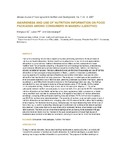Please use this identifier to cite or link to this item:
http://hdl.handle.net/10311/580| Title: | Awareness and use of nutrition information on food packages among consumers in Maseru (Lesotho) |
| Authors: | Mahgoub, S.E. Lesoli, P.P. Gobotswang, K. |
| Keywords: | Consumers Food packages Nutrition information |
| Issue Date: | 2007 |
| Publisher: | Rural Outreach Program. http://www.bioline.org. |
| Citation: | Mahgoub, S.E., Lesoli, P.P. & Gobotswang, K. (2007) Awareness and use of nutrition information on food packages among consumers in Maseru (Lesotho), African Journal of Food, Agriculture, Nutrition and Development, Vol. 7, No. 6, pp. 1-16 |
| Abstract: | Food product labelling has become a popular policy tool, particularly with respect to the provision of nutrition and health information. Nutrition labelling is a valuable tool in learning how to apply nutrition information in a practical way. Nutrition information on food labels can help consumers to choose healthier food. For companies competing in the global food and beverage marketplace, understanding local consumer attitudes and purchase behaviour regarding healthy foods, nutrition, and labelling is critically important for success. This study attempts to evaluate the level of knowledge and use of nutrition information on food packages among consumers in Maseru, Lesotho. A structured questionnaire, covering aspects of knowledge and use of food labels and nutrition information, was used to collect information from two hundred and sixty consumers. The study also included open-ended questions on what consumers expected to be on the food label, what they understand by nutrition information, what its importance is, and if they think it should be included on the food package labels and why. The findings indicate that the main demographic features of the participants were: 67.3% female, 59.6% married, 55.9% completed primary, middle or high school, and 68.4% were poor. Majority (71.2%) of the participants claimed that they use a shopping list. Less than half of the participants (40.5%) indicated that nutrition information on food labels, rather than price, taste, appearance, habit, convenience, or brand name, was their main motivator to purchase foods. With regard to food label and nutrition information knowledge, a majority of the participants said they knew about them (59.6% for food label knowledge, and 69.2% for nutrition information knowledge). The same trend has been observed with respect to use of nutrition information on food labels when shopping, where 63.8% claimed that they utilise that knowledge when shopping. For the lowest income group, food price was the major determining factor of the types of foods they buy. A positive relationship between age of participants and nutrition information knowledge was observed. It was noted that as the level of education increased, the level of knowledge about food label increased. The level and use of nutrition knowledge when purchasing foods increased with age, education level and family income. Answers to the open-ended questions showed high degree of awareness about nutrition information on food labels, and why it is important to utilise that information. |
| URI: | http://hdl.handle.net/10311/580 |
| ISSN: | 1684-5358 |
| Appears in Collections: | Research articles (Dept of Family and Consumer Sciences, formerly Home Economics Education) |
Files in This Item:
| File | Description | Size | Format | |
|---|---|---|---|---|
| Gobotswang_AJFAND_2007.pdf | 527.28 kB | Adobe PDF |  View/Open |
Items in DSpace are protected by copyright, with all rights reserved, unless otherwise indicated.
